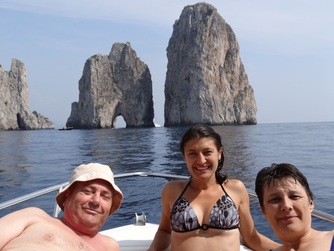



My sister, in her blog Live Love Laugh, wrote about the phrase Carpe Diem from the perspective of a woman who has undergone great tragedy but uses this philosophy as a way to embrace life rather than withdraw from it. As we traveled South of Rome with Neda’s family (they joined us there for a little backpacking family vacation) to Naples and the Amalfi Coast, Carpe Diem became not just a philosophy, but a historical signpost painted over every attraction we visited.  An ominous mural from Pompeii First up was bustling Naples, which with its dirty alleyways connected by interwoven laundry lines was a bit reminiscent of Southeast Asia. The old town’s buildings tower over you as you walk along narrow streets, and the variety of people and noises thrum like the oceans waves. Our main purpose in town was two-fold – eat as much pizza as possible (Naples is the home of pizza!) and visit the Museo Archeologico Nazionale di Napoli, where the treasures of nearby Pompeii and Herculaneum now reside. Both towns were covered under volcanic debris with the explosion of nearby Mount Vesuvius in 79 AD and after being discovered and excavated, stand as some of the best preserved examples of Roman architecture and art available to us today. In the museum, wonderfully vivid murals, sculptures, and paintings have been preserved from the two cities – depicting the mythological, sexual, and everyday art of which the people of Rome adorned their homes and temples. My sister’s philosophy rang through the halls as I imagined the people huddling for shelter while volcanic mud claimed their lives and embedded them into our imagination 2000 years later.  A recent pic of our lady On the pizza front, we ate at “Brandi Pizzeria” the first pizzeria in the world and home of the traditional pizza margherita, which was created in 1889 when the chef of Brandi created a pizza with tomato, mozzarella cheese, and basil for the visit of Queen Margherita di Savoia. Meant to represent the Italian flag with its ingredients, this was the first time cheese was added to this flat bread, transforming it into one of the most popular foods in modern history. Today, the pizza chefs at Brandi are still slinging delicious pies as we found out in person. Though it must be said that for us there is only one Brandy truly in our lives – we miss you little one! It was a thoroughly successful day in Naples, and was followed the next day by a trip to the ancient ruined cities in person where we walked the streets that bustled with life prior to the eruption. Herculaneum is smaller and better preserved than Pompeii, making it a favorite with its ruined bathhouses, villas, and food shops while Pompeii offers a glimpse of the vast destruction caused by Vesuvius.  Nadia and Petko at Amalfi From Pompeii we traveled around the bay of Naples to station ourselves in Sorrento for the exploration of the Amalfi Coast. The coast is named after the maritime empire of the city of Amalfi that once dominated the area. But “Carpe Diem” would linger in our minds when we learned that most of the city, with its population of 70,000 souls, slid into the sea along the steep cliffs of the coastline during an earthquake and ensuring tsunami in 1343. The theme resonated even deeper in our brains as we tottered and swerved along the coastal road on the public bus to get to Positano and Amalfi, only a meter or so away from the steep cliffs that claimed the city hundreds of years before. Today both Positato and Amalfi sit along the coast in defiance of their location, beautiful cities carved upward from the edge of the cliffs into the hills above. We enjoyed perusing the art galleries and letting our eyes water at the prices of food and drink before returning back the way we came on an overcrowded bus trip that afforded beautiful views of the setting sun.  Finally, we headed to the Island of Capri, fabled location of Emperor Tiberius’ summer home and popular jet-setting destination. We rented a “motorized dinghy” to get the real tour of the island and spent four hours gaping at the island’s sheer rock walls lifting out of the sea, snorkeling at the green and white grottos, and sailing through the arched gap in the Faraglione di Mezzo with our little dinghy. As we rounded the island, we could see the fabled Tiberius’ Leap, where legend has it the emperor would have undesired guests and disobedient servants thrown. Near the end of the ride, as we crossed the wake of a giant ferry, we felt like one of Tiberus’ guests and said a final Carpe Diem as the bow of boat lurched upward to the sky before finally settling back safely into the frothy sea. Seeing the precariousness of life over history in the Bay of Naples region beckons one to find appreciation in whatever moments we have on this globe. On this part of the trip we found that appreciation in the time spent with family and the beauty of Italy’s coast. I still hope each day that my sister and her husband continue to find it as they struggle to seize the day in the midst of a tragedy just as world ending as any volcanic eruption or earthquake could ever be.
0 Comments
Leave a Reply. |